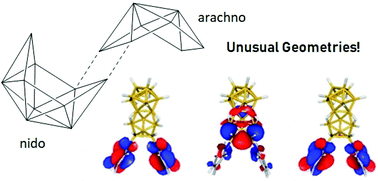当前位置:
X-MOL 学术
›
Dalton Trans.
›
论文详情
Our official English website, www.x-mol.net, welcomes your feedback! (Note: you will need to create a separate account there.)
Substitution of the laser borane anti-B18H22 with pyridine: a structural and photophysical study of some unusually structured macropolyhedral boron hydrides†
Dalton Transactions ( IF 4 ) Pub Date : 2018-01-08 00:00:00 , DOI: 10.1039/c7dt03823b Michael G. S. Londesborough 1, 2, 3 , Jiří Dolanský 1, 2, 3, 4, 5 , Tomáš Jelínek 1, 2, 3, 6, 7 , John D. Kennedy 1, 2, 3, 8, 9 , Ivana Císařová 3, 4, 5, 10 , Robert D. Kennedy 8, 9, 11 , Daniel Roca-Sanjuán 12, 13, 14 , Antonio Francés-Monerris 12, 13, 14 , Kamil Lang 1, 2, 3 , William Clegg 11, 15, 16, 17
Dalton Transactions ( IF 4 ) Pub Date : 2018-01-08 00:00:00 , DOI: 10.1039/c7dt03823b Michael G. S. Londesborough 1, 2, 3 , Jiří Dolanský 1, 2, 3, 4, 5 , Tomáš Jelínek 1, 2, 3, 6, 7 , John D. Kennedy 1, 2, 3, 8, 9 , Ivana Císařová 3, 4, 5, 10 , Robert D. Kennedy 8, 9, 11 , Daniel Roca-Sanjuán 12, 13, 14 , Antonio Francés-Monerris 12, 13, 14 , Kamil Lang 1, 2, 3 , William Clegg 11, 15, 16, 17
Affiliation

|
Reaction of anti-B18H221 with pyridine in neutral solvents gives sparingly soluble B16H18-3′,8′-Py23a as the major product (ca. 53%) and B18H20-6′,9′-Py22 (ca. 15%) as the minor product, with small quantities of B18H20-8′-Py 4 (ca. 1%) also being formed. The three new compounds 2, 3a and 4 are characterized by single-crystal X-ray diffraction analyses and by multinuclear multiple-resonance NMR spectroscopy. Compound 2 is of ten-vertex nido:ten-vertex arachno two-atoms-in-common architecture, long postulated for a species with borons-only cluster constitution, but previously elusive. Compound 3a is of unprecedented ten-vertex nido:eight-vertex arachno two-atoms-in-common architecture. The single-crystal X-ray diffraction analysis for the picoline derivative B16H18(NC5H4Me)23b, similarly obtained, is also presented. B18H20Py 4 is also previously unreported but is of known ten-vertex nido:ten-vertex nido two-atoms-in-common architecture of anti configuration, but now with the pyridine ligand positioned differently to other reported examples of B18H20L compounds. Factors behind the remarkably low solubility of 3a and 3b are elucidated in terms of electrostatic potential (ESP) calculations, polarity, and van der Waals complementarities. In view of contemporary developing high interest in the fluorescent properties of macropolyhedral boron-containing species, a detailed assessment of the photophysical characteristics of 3a and 4 is also presented. In contrast to the thermochromic fluorescence of 2 (from 620 nm brick-red at room temperature to 585 nm yellow at 8 K, quantum yield 0.15), compound 3a is only weakly phosphorescent in the yellow region (590 nm, quantum yield 0.01), whereas compound 4 exhibits no luminescence. The far more photoactive nature of compound 2 is associated with S1 excited-state minima structures that differ from each other only by the relative rotational positions of the pyridine substituents on its disubstituted ten-vertex {arachno-B10Py2}-subcluster. The wavelength and relative intensity of fluorescence from these structures depends on the rotational positions of the pyridine ligands, which in turn are influenced by temperature and/or rotational inhibition in the solid-state.
中文翻译:

用吡啶 取代激光硼烷抗-B 18 H 22:一些异常结构化的多面体氢化硼的结构和光物理研究†
抗-B 18 H 22 1与吡啶在中性溶剂中反应,得到微溶的B 16 H 18 -3',8'-Py 2 3a作为主要产物(约53%)和B 18 H 20 -6', 9'-Py 2 2(约15%)为次要产物,还形成少量的B 18 H 20 -8'-Py 4(约1%)。三个新的化合物2,图3a和4通过单晶X射线衍射分析和多核多共振NMR光谱表征。化合物2具有10个顶点的nido:10个顶点的Arachno两种常见原子结构,长期以来假定该结构仅具有硼簇结构,但以前难以捉摸。化合物3a具有前所未有的十个顶点nido:八个顶点常见的两个原子的蛛网结构。还介绍了类似地获得的甲基吡啶衍生物B 16 H 18(NC 5 H 4 Me)2 3b的单晶X射线衍射分析。乙18 H 20 Py 4先前也未报道,但已知是十构型的nido:十构型的nido,具有两个原子的共同构型,具有反构型,但现在吡啶配体的位置与B 18 H的其他实例不同20升化合物。3a和3b的极低溶解度背后的因素根据静电势(ESP)计算,极性和范德华互补性进行了阐明。鉴于当代对含多面体硼的物种的荧光性质的高度关注,还提出了对3a和4的光物理特性的详细评估。与2的热致变色荧光(从室温下的620 nm砖红色到8 K下的585 nm黄色,量子产率0.15)相比,化合物3a在黄色区域(590 nm,量子产率0.01)仅微弱磷光,而化合物4没有发光。化合物2具有更高的光活性,这与S 1有关仅在其二取代的十个顶点{ arachno -B 10 Py 2 }-亚簇上的吡啶取代基的相对旋转位置上彼此不同的激发态最小结构。来自这些结构的荧光的波长和相对强度取决于吡啶配体的旋转位置,而吡啶配体的旋转位置又受固态中的温度和/或旋转抑制的影响。
更新日期:2018-01-08
中文翻译:

用吡啶 取代激光硼烷抗-B 18 H 22:一些异常结构化的多面体氢化硼的结构和光物理研究†
抗-B 18 H 22 1与吡啶在中性溶剂中反应,得到微溶的B 16 H 18 -3',8'-Py 2 3a作为主要产物(约53%)和B 18 H 20 -6', 9'-Py 2 2(约15%)为次要产物,还形成少量的B 18 H 20 -8'-Py 4(约1%)。三个新的化合物2,图3a和4通过单晶X射线衍射分析和多核多共振NMR光谱表征。化合物2具有10个顶点的nido:10个顶点的Arachno两种常见原子结构,长期以来假定该结构仅具有硼簇结构,但以前难以捉摸。化合物3a具有前所未有的十个顶点nido:八个顶点常见的两个原子的蛛网结构。还介绍了类似地获得的甲基吡啶衍生物B 16 H 18(NC 5 H 4 Me)2 3b的单晶X射线衍射分析。乙18 H 20 Py 4先前也未报道,但已知是十构型的nido:十构型的nido,具有两个原子的共同构型,具有反构型,但现在吡啶配体的位置与B 18 H的其他实例不同20升化合物。3a和3b的极低溶解度背后的因素根据静电势(ESP)计算,极性和范德华互补性进行了阐明。鉴于当代对含多面体硼的物种的荧光性质的高度关注,还提出了对3a和4的光物理特性的详细评估。与2的热致变色荧光(从室温下的620 nm砖红色到8 K下的585 nm黄色,量子产率0.15)相比,化合物3a在黄色区域(590 nm,量子产率0.01)仅微弱磷光,而化合物4没有发光。化合物2具有更高的光活性,这与S 1有关仅在其二取代的十个顶点{ arachno -B 10 Py 2 }-亚簇上的吡啶取代基的相对旋转位置上彼此不同的激发态最小结构。来自这些结构的荧光的波长和相对强度取决于吡啶配体的旋转位置,而吡啶配体的旋转位置又受固态中的温度和/或旋转抑制的影响。


























 京公网安备 11010802027423号
京公网安备 11010802027423号